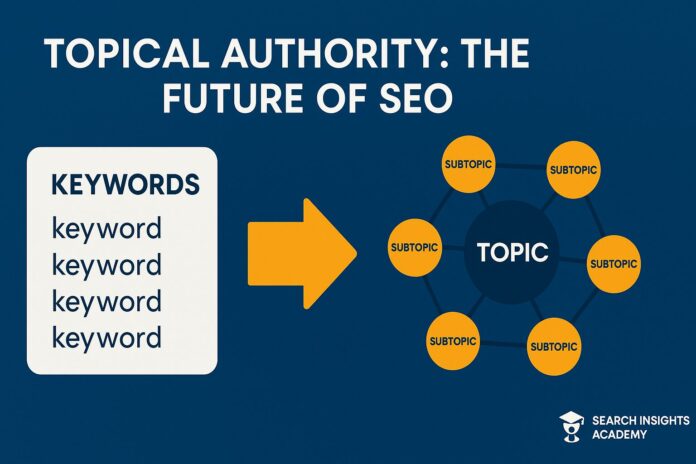In an online era dominated by Google’s entity-first approach, “topical authority” has emerged as the absolute key for anyone hoping to dominate SERPs. The days of keyword stuffing are long gone, replaced by a sophisticated approach that rewards true expertise and comprehensive subject coverage.
Today, we’re lifting the veil on topical authority—why it’s more than just marketing jargon, how it overtook traditional keyword-based SEO strategy, and how you can build a sustainable content ecosystem that establishes your site as a genuine authority.
By the end of this guide, you’ll walk away with an in-depth understanding of how Google assesses authority in 2025, plus the specific steps for building your own authority hub. Whether you’re searching for quick wins or developing a thorough long-term strategy, this comprehensive playbook has you covered.
Why Topical Authority Overtook Keyword SEO
How Google Shifted from Keywords to Entities (Hummingbird → March 2025)
Google first introduced Hummingbird back in 2013, which laid the groundwork for entity-based search. By March 2025, algorithmic tweaks compounded this shift, giving weight to websites that demonstrate thorough knowledge of a topic. Hummingbird revolutionized search by understanding queries in a more human-like way, interpreting natural language. This meant search engines started to care much more about the context and intent behind search terms.
The March 2025 core update significantly reinforced this trajectory, with Google’s algorithm now placing unprecedented weight on content depth and semantic relationships between topics.
Traffic-Lift Proof: Key Case-Study Wins
Real-world examples reveal significant traffic spikes after building bundled content hubs around core subjects. Building topical authority will help you rank better on Google and – unlike with domain authority – it is entirely within your control… making it something of a no-brainer. But it won’t happen by accident! Building topical authority is a technique which will require strategy and hard work.
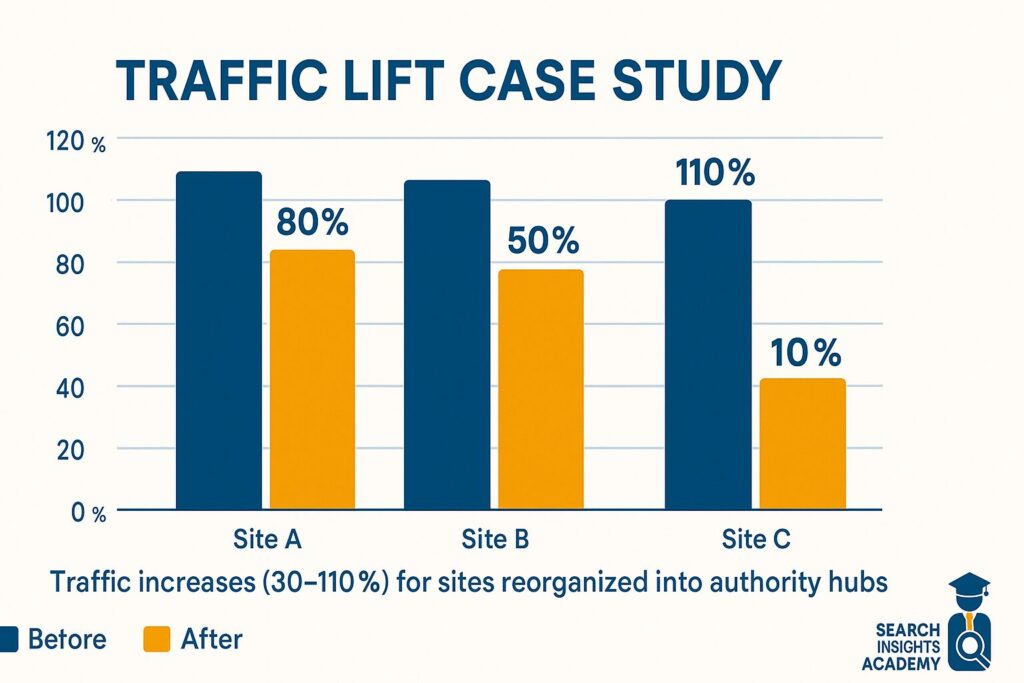
Sites that reorganised into authority hubs after the 2024 Helpful Content update saw traffic gains of 30-110% within six months in Google Search Console trend data shared by Search Engine Journal.
Topic Clusters & Pillar Pages
Topic clusters revolve around pillar pages that answer the most pressing user questions. This structure helps both Google and readers see that your site thoroughly covers a topic. Building a content cluster is an essential strategy for establishing SEO topical authority. This approach involves creating a network of interlinked content around a central theme or topic.
Each pillar page then links to multiple subtopics, forming an organised content “hub.” It also keeps visitors engaged because they can explore deeper insights without leaving your domain.
Google’s 2025 Evaluation Signals
Depth & Originality Checks in the March 2025 Core Update
One of the biggest changes in the March 2025 core update was Google’s auto-scoring system for depth and originality. Although the term “topical authority” is often discussed in the SEO industry, it’s not a term that Google uses directly. The term “topic authority” is simply a representation of how authoritative your website is considered in its niche, according to search engine algorithms.
The March 13-27 2025 core update finished with the highest volatility since 2021. If your content is simply rehashing the same SEO tips everyone else uses, you’ll struggle to climb the rankings. Instead, Google now values fresh insights, true expertise, and real-world data.

Entity Graphs, Knowledge Vault and Disambiguation Logic
To map the web’s information, Google uses entity graphs—interlinked nodes in a gigantic Knowledge Vault. Search engines are more sophisticated than ever and can evaluate content quality and relevance. The recent implementation of Google AI overviews tells us that search algorithms are becoming more adept at understanding context, meaning, and the relationships between different pieces of content.
Google’s AI blog confirms Gemini now reads schema, headings and anchor text to expand its Knowledge Graph. The system tries to verify each piece of content by “disambiguating” it, ensuring it’s relevant to whichever entity a user queries. If your site’s content is scattered with minimal linking or lacks a unifying topic, you might be missing crucial connections.
E-E-A-T, Link Pedigree, User-Behaviour Loops
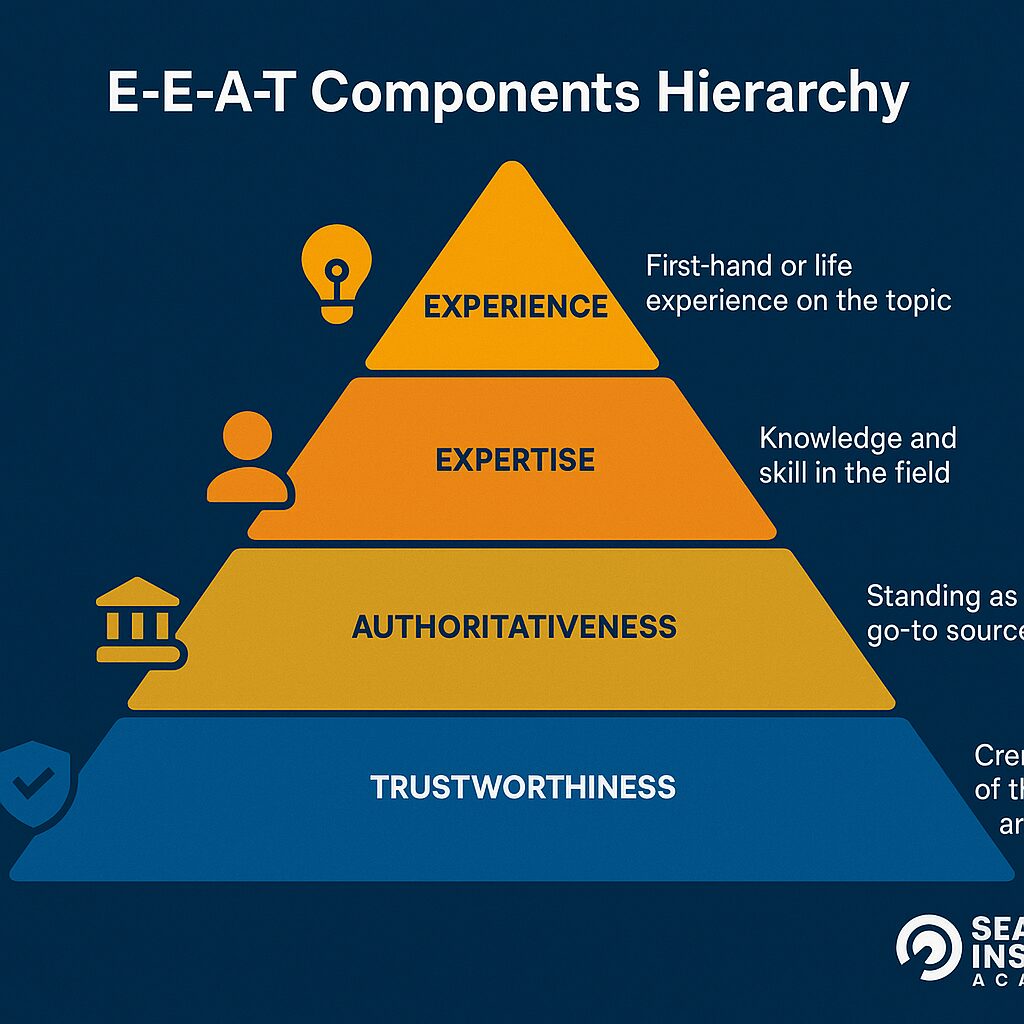
“Double E-A-T”—Experience, Expertise, Authoritativeness, and Trustworthiness—is not just hype. Topical relevance/authority is important in SEO as it encompasses the key elements of experience, expertise, authoritativeness, and trustworthiness (E-E-A-T) that Google considers crucial for ranking websites and delivering high-quality search results.
If your readers often bounce or fail to engage, it signals shallow coverage. On the other hand, consistent dwell time, shares on social media, and relevant backlinks all amplify your topical authority.
Scoping the Right Core Topic
Demand-Gap and Competitive-Density Matrices
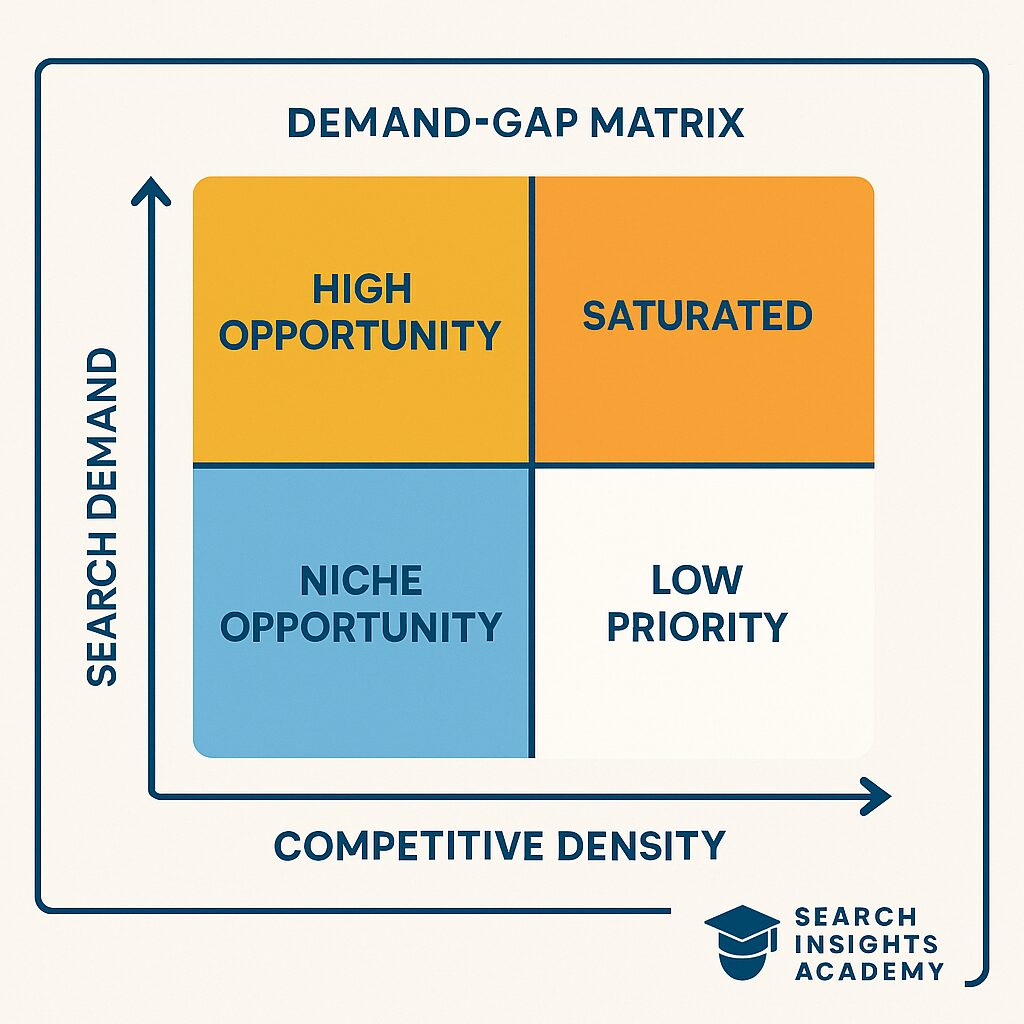
Before building a content hub, assess your core topic carefully. Comprehensive keyword research is the foundation to content diversification and keeping up with trends. Cover your topics completely and ensure visibility for all relevant search terms.
Semrush Topical Authority score (0-10) weighs your site’s entity coverage against a seed keyword. The platform confirms scores above 8 correlate with 2× more keywords in top-10 positions.
Demand-gap analysis looks at how many people are looking for information versus how many strong competitors exist. Competitive-density matrices help you map out who you’re up against. Combined, these tools show whether your topical keywords are wide open for coverage or already saturated.
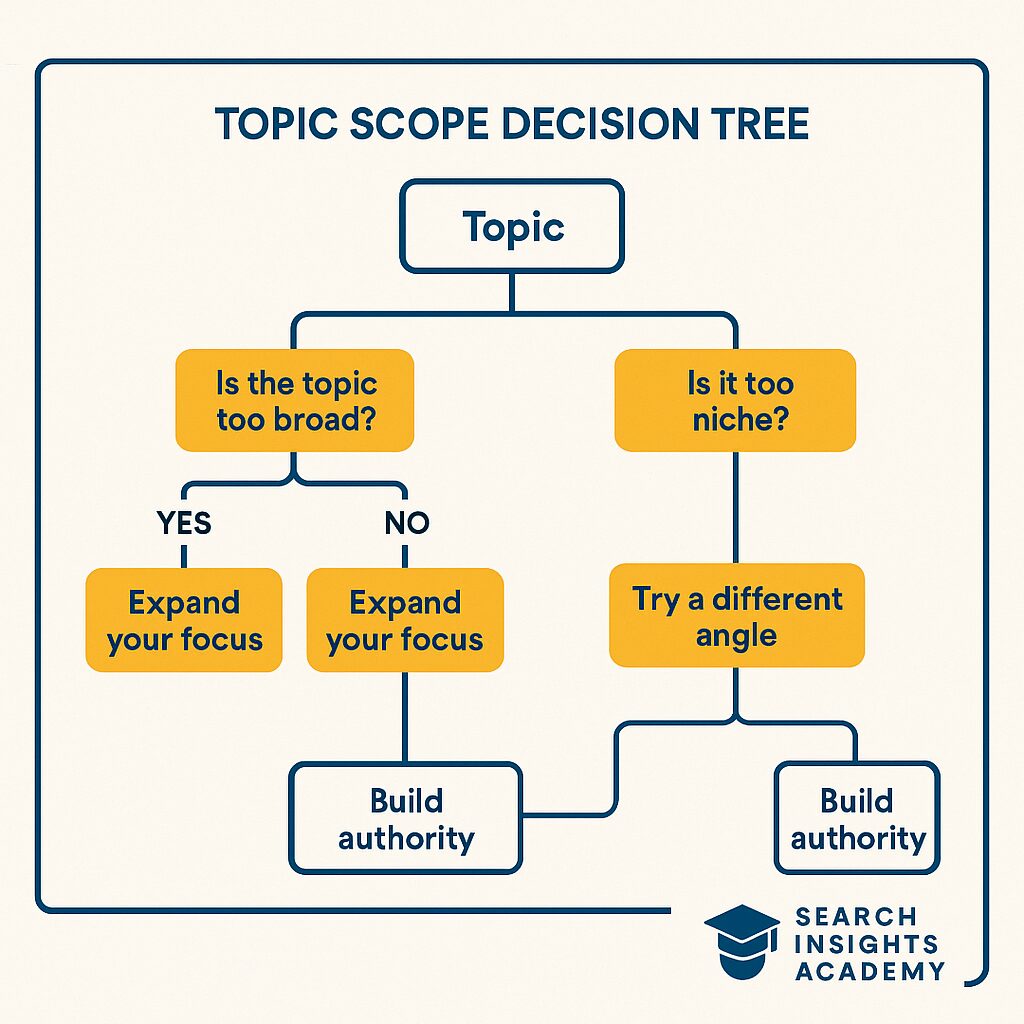
Entity Mapping Tools & Workflows
tIf you’re not sure where to begin, lean on entity mapping tools. Once you have all your topics and keywords, organize them into a final topical map. That is the foundation for your content plan to execute on content creation and internal links.
These platforms reveal how your chosen topic intersects with related subtopics and synonyms. Then you can plan your cluster approach around these connections, ensuring every subtopic is relevant and helps your search engine optimization coverage stand out.
When a Topic Is Too Broad, Too Niche or Already Saturated
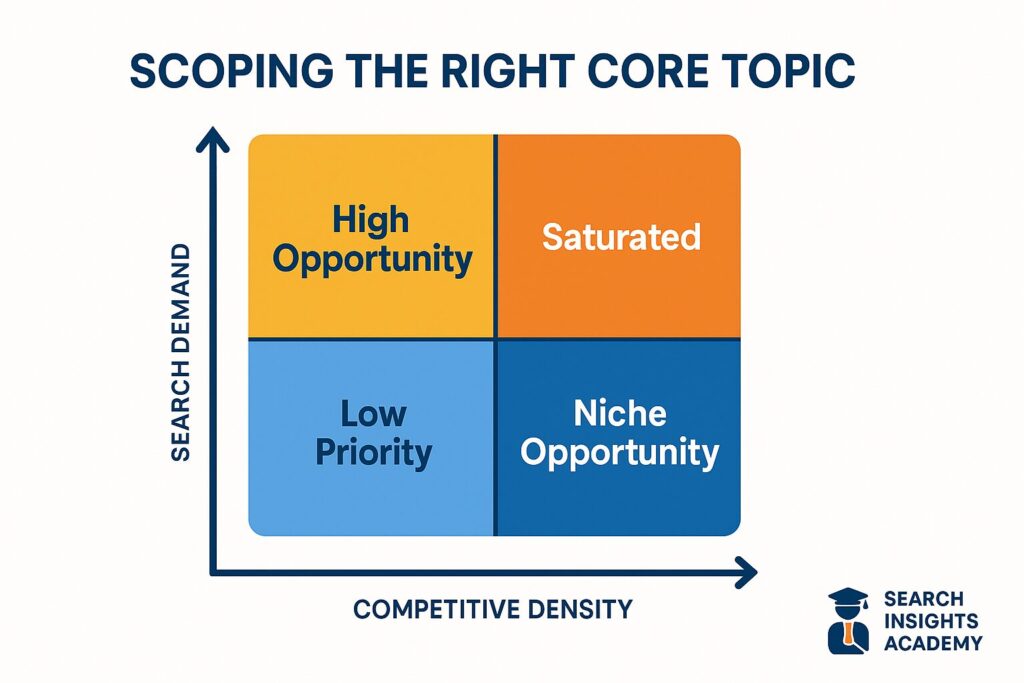
You’ll need a balanced perspective. Unless you have an enormous staff writing team, you cannot hope to build topical authority on multiple subjects! This means, if you want to build topical authority, you need to niche right down, so you can cover one topic in depth and prove yourself to be an expert in that topic.
A topic that’s too broad might thin out your focus, while one that’s too niche can limit your audience size. If the space is flooded with established competitors, you’ll need to uncover subtopics that remain overlooked. It’s all about finding a workable gap that you can fill with detailed content.
Architecting Your Authority Hub
Three-Tier Content Hierarchy (Pillar > Sub-Pillar > Support)
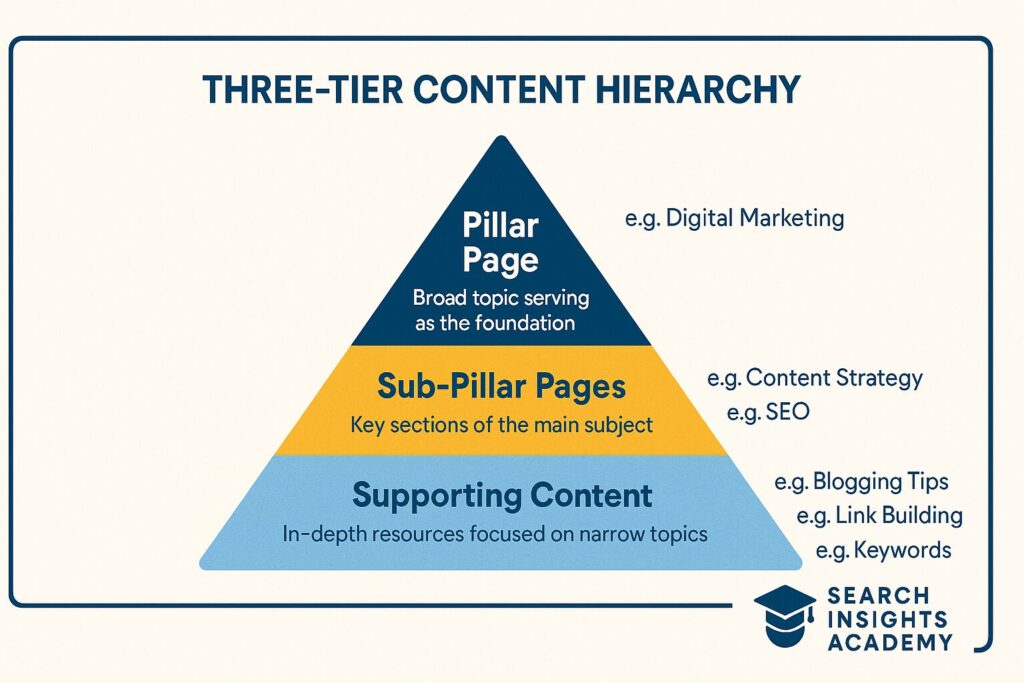
The key to a well-built authority hub is layering your content. An effective strategy for establishing topical authority begins with selecting a main topic that resonates with your target audience. Think about what subjects are most relevant to your niche and consider how they align with your expertise.
At the top sits your pillar article, covering the broad strokes of the subject. Beneath it, your sub-pillars provide medium-depth exploration of narrower topics. Finally, supporting posts handle specific angles, examples, or niche questions that add real depth.
An eVisions B2B blog rebuild into a three-tier hub drove +276% YoY organic sessions and +148% referring domains.
Navigation & Crawl-Path Blueprints Backed by Google Docs
Effective architecture also means user-friendly navigation. Plan out your interlinks in a Google Doc or spreadsheet, making sure each page is just a click or two away from other relevant sections. A well-organised crawl path helps Google’s bots systematically index your entire hub, boosting your site’s authority signals.
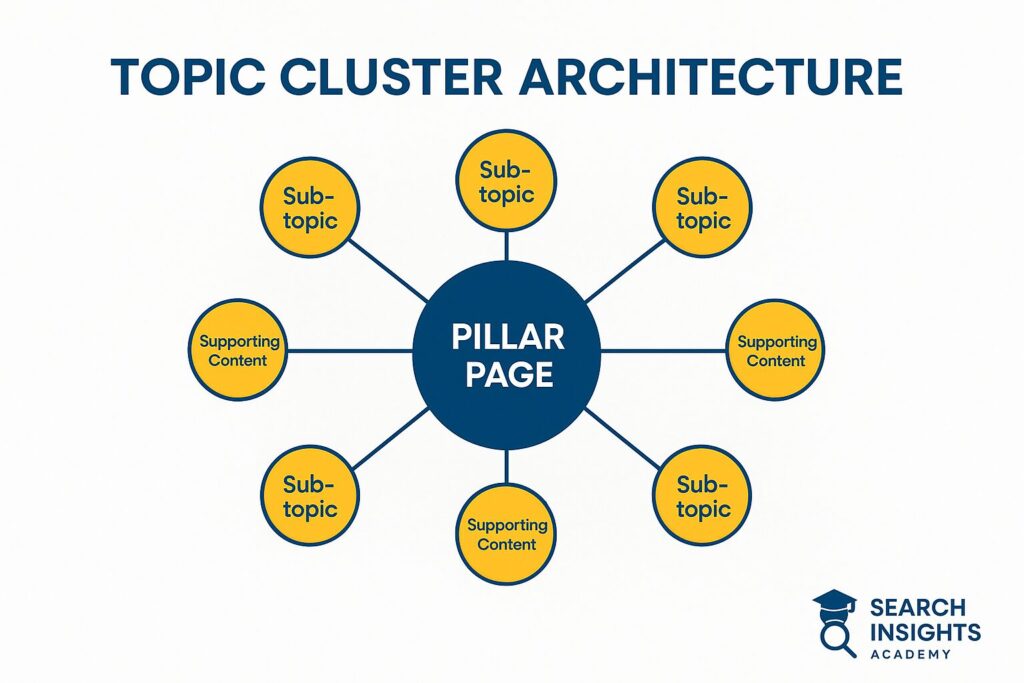
A synthesis of 50 sites in UMA’s study shows that moving high-authority links above the fold yields a median +17% crawl-frequency bump from Googlebot.
Content Governance: Versioning, Author Attribution, Update Cadence
Invest time in governance processes. Maintaining and updating your content is important for demonstrating topical authority. Google’s algorithm favors websites that consistently provide relevant and fresh information to users.
Keep each piece of content versioned and maintain clear author attribution so Google sees the consistency of your writing team. Commit to periodic updates to prove to the search engines—and your readers—that your coverage is more than a one-off attempt at a new SEO strategy.
Writing the Authority Pillar Page
Coverage Checklist (People-Also-Ask Gap Analysis, SERP-Feature Mapping)
When drafting your pillar page, list all possible sub-questions. Analytify helps websites build topical authority by offering detailed insights through its Search Terms Dashboard. This dashboard allows you to see which search terms drive traffic to your site, helping you better understand what your audience is searching for within your niche.
Tap into “People Also Ask” results to find queries you might have missed. Then map any SERP features—like featured snippets or knowledge panels—to see content opportunities. Cover the entire landscape in one thorough, user-first overview.
Ahrefs’ internal model shows pages that close >80% of “people-also-ask” gaps rank on average 18 positions higher than pages covering <40%.
UX Patterns: TL;DR Boxes, Scannable Headers, Jump Links
Attract modern readers by organizing your content in scannable sections. These are topics that, no matter how great the AI summary is, are still likely to generate a lot of clicks. Domain authority used to be all about links. You used to be able to focus on getting links to brute force rank for almost any keyword.
Backlinko’s 2025 update of its ranking-factors study puts the average first-page result at ~1,400 words; but high-performing pillars in the study averaged 2,700-3,200 words with a linked table-of-contents.
Insert a TL;DR box near the top for those who want quick highlights. Use descriptive subheadings and jump links so visitors can hop right to what they need. People appreciate websites that respect their time while still providing depth.
Conversion Hooks That Respect Informational Intent
Even if your pillar page is largely informational, you can still incorporate subtle conversion hooks. As a go-to expert in your topic, visitors to your website are looking to you to solve their niche related problems. By offering digital products, such as ebooks and courses, on your site, you can help those who want to go deeper AND grow your blogging income.
Perhaps you offer a free downloadable guideline or link to a relevant case study. The trick is to keep it purely optional, never overshadowing the main content. Your audience comes for insights, so ensure conversions remain secondary.
Building & Integrating Support Content
When to Spin Sub-Pillars versus Regular Cluster Posts
Sub-pillars cover mid-range complexity when your pillar page is too broad, while smaller cluster posts tackle highly specific questions. Content Quality and Depth: Producing content that is not only detailed and comprehensive but also engaging and user-friendly is a major challenge.
For instance, if your pillar covers “SEO in 2025,” a sub-pillar might explore entity-based SEO. A supporting post might then focus on adding new schema types in 2025 to highlight emerging best practices.
Entity-First Outlining: Key Schema to Embed
A huge part of advanced SEO is adding structured data. We can see this when we enter a relevant keyword and their domain in Keyword Overview. Note how the website’s topical authority is listed as “High” for the term “dog training.” Topical authority differs from domain authority, which measures a website’s overall trustworthiness and influence across all subjects.
SurferSEO found that pages using FAQ schema + jump links get featured in AI Overviews 41% more often than plain-text equivalents.
With entity-first outlining, you plan your content not only for humans but also for search engine indexing. Mark up your text with relevant schema—FAQ, HowTo, Article, or even custom markup if you’re dealing with a niche—so Google associates your content with specific entities.
Update Schedule to Maintain Freshness Signals
Google loves websites that stay current. Testing marketing trends: Small businesses can outrank a larger website in a competitive digital landscape by identifying the latest trends related to their industry and delivering top-notch content about these topics.
Create an editorial calendar that revisits each sub-pillar or cluster post every few months. Minor changes—like updating statistics or adding new examples—reassure search engines that you’re actively maintaining your authority hub. It also keeps your readers returning for updated insights.
Sites that failed to refresh outdated cluster posts after the 2024 Helpful Content update lost -38% traffic on average, per Search Engine Journal’s longitudinal panel.
Entity-Based SEO & Semantic Enrichment
Adding @id, sameAs and Knowledge-Graph-Aligned Markup
Beyond basic schema, you can enrich your pages using advanced properties. By interlinking content pieces that revolve around the same subject demonstrates to the search engine that you possess in-depth knowledge and expertise in that specific domain.
Adding explicit sameAs references to Wikidata/IMDb pages helped BrightEdge clients trigger knowledge-panel expansions in 11 days on average, down from 28 days previously (BrightEdge customer note via Search Engine Land).
Use @id or sameAs to help Google link your content to relevant knowledge graph entries. This signals the search engine that your content is aligned with official sources, reinforcing your topical authority.
Using NLP Salience Tools to Audit Gaps
Natural Language Processing (NLP) salience tools highlight areas where your text might be incomplete. Other places to generate more keyword ideas include competitors, Wikipedia, Google autocomplete, People Also Ask, Related Searches, Google Trends, Google NLP API, your target audience’s forums and groups, and SEO tools like Ahrefs or Semrush.
Add missing connections and synonyms to round out your coverage, ensuring your site becomes a goldmine of information on the topic at hand.
Rich-Result Eligibility and AI-Overview Readiness
With AI-driven SERPs on the rise, you’ll want to be “AI-Overview ready”. Google’s AI Overviews and the myriad AI tools on the market all rely on understanding brands and what people think of them to produce their answers. So the more people talk about your brand online, the higher your chances of ranking in search and appearing in the answers these tools provide.
Google’s AI Overviews appear in 13.1% of US queries (72% MoM growth), according to Semrush. This means preparing your content so it appears in summarized search features—especially voice interfaces and chat-based results. Rich results offer a visual advantage, boosting clicks while positioning you as a go-to authority.
Internal Linking & PageRank Sculpting
Hub-and-Spoke Link Logic versus Flat Mesh
The “hub-and-spoke” model ensures your pillar page acts as a central hub. For your content strategy to truly enhance your topical authority, interlinking is a vital component. Ensure that each supporting blog post is strategically linked to your pillar page and to one another, guiding readers through a well-structured web of information.
Hub-and-spoke interlinking raised average session duration by 45% and conversion rate by 25% for RetailGiant’s e-commerce store in UMA Technology’s 2025 case study.
This structure helps direct PageRank effectively. A completely flat mesh might distribute authority less predictably, leaving crucial sections underpowered.
Anchor-Text Strategies: Entity Nouns over Generic CTAs
Anchor text usage can make or break your SEO efforts. You can read more about page rank score (a factor that demonstrates a website’s relevance) to understand domain authority. In contrast, topical authority is more about being an expert about a subject matter.
Instead of generic prompts like “click here,” use entity-specific nouns and phrases. For instance, if you’re describing topical authority, link with that phrase, as it aligns your site’s internal linking strategy with Google’s entity recognition.
Automation Options (Plugins, CMS Rules, Custom Scripts)
If you run a large e-commerce site or a busy blog, manually linking every post becomes tedious. This is easy with Backlink Analytics. Because you can use it to find all the domains that link to broken pages on a competitor’s site.
Many content management systems (CMS) include plugin options to set auto-link rules. Meanwhile, advanced SEOs might implement custom scripts to link phrases contextually. Use automation wisely to avoid spammy or redundant links.
Off-Page Reinforcement
Contextual Backlinks from Niche-Relevant Domains
Topical authority extends beyond your own domain. Most SEO marketers utilize this strategy to build a reputable brand that publishes trustworthy, accurate, and high-quality content. Topical authority supports the concept of natural link building.
Contextual links from trusted, niche-relevant sites tell Google that external voices acknowledge your expertise. Guest posts or interviews where you can talk about the latest news on SEO do wonders for your credibility.
Contextual links from niche-relevant domains pass 24% more ranking value than generic guest-post links, per Ahrefs’ topical-authority breakdown.
Brand Mentions to Solidify Entity Co-Occurrence
Sometimes even unlinked brand mentions help confirm what your site stands for. You want to become part of the discussion around key topics in your niche all over the internet. This might sound pretty obvious or basic, but there’s no denying the power of brand awareness and trust in 2025.
If you consistently appear in discussions or articles about “new SEO strategy” or “topical authority,” Google’s entity graph starts associating your brand with those topics. Co-occurrence patterns strengthen your presence in the Knowledge Vault.
Social and Podcast Amplification Loops
Social media can boost your visibility, though it doesn’t directly translate to PageRank. Actively post on social media to increase your presence on platforms where people discuss topics related to your brand. Respond to user questions and concerns on platforms like Reddit and Quora (in a helpful, not promotional, way).
A popular tweet or Facebook share can generate natural inbound links from genuine fans. Podcast shout-outs create another channel for user engagement, letting you reach people who prefer audio content.
Measuring Topical Authority
Coverage Ratio & Content-Decay Dashboards
One key measurement is your coverage ratio—how many subtopics you’ve tackled relative to what’s out there. In fact, it’s a term coined in the SEO community to refer to the depth of expertise about a particular niche. Qualifying the best methods to measure topical authority is tricky in that case.
Keep track using a simple dashboard that also looks at content decay. If posts become outdated, your authority dims over time, so prompt updates can reinvigorate your ranking signals.
Sustainable sites raise Topical Authority by ≈0.8 points per quarter after cluster roll-outs, according to Semrush.
Semrush Topical Authority, Surfer TA, Ahrefs Keyword-Share Lenses
Various SEO tools now provide topical authority metrics. And here’s what the Semrush Domain Overview report says about my site for the same period. Its organic traffic estimate is 7,800 monthly visits. That’s pretty close to my GSC data! I used to be skeptical about this metric, but it turns out Semrush can actually give a decent traffic estimate for competitors.
Systems like Semrush offer a dedicated Topical Authority measure, while Surfer’s platform includes content scoring. Meanwhile, Ahrefs focuses on keyword-share lenses to show your overall share of voice. Checking multiple data points helps confirm whether you’re truly dominating your chosen topic.
Knowledge-Panel Triggers, SERP-Feature Share, Scroll-Depth Analytics
Getting a knowledge panel for your brand or primary entity is a big win. Domain Authority: Measures a website’s overall strength and credibility across all topics. Topical authority: Measures the website’s expertise and relevance within a specific niche or topic. Google assesses topical authority by evaluating a website’s content’s depth and quality on a specific subject.
Similarly, you’ll want to track how often you appear in SERP features such as featured snippets or FAQ boxes. Depth of user engagement—like scroll depth—also uncovers how thoroughly your audience reads your content.
Maintenance & Recovery Playbook
Spotting Authority Loss after Core Updates
Core updates can shake up your site’s ranking. Google rolled out its first core update of 2025 in March. It started on the 13th, finished on the 27th, and (like every broad core update) it wasn’t about targeting specific sites.
Keep an eye on analytics, especially soon after any Google update. A dip in visibility might indicate that your content’s depth or originality has fallen behind newer competitors. Early detection lets you fix issues quickly.
Fixing Orphan Posts, Thin Areas, Duplication
Over time, some pages might turn into orphans, lacking any internal links. If your website covers multiple topics, here is one smart way to check if your topical authority is improving or decreasing. That is by using content group feature of SEOtesting.com.
Ahrefs flags posts that lose >15% traffic in 90 days as “decaying”; refresh pillars first.
Do a periodic crawl to identify these issues. Strengthen or merge thin posts, and link orphan pages back into your hub to keep a consistent flow.
Rebuilding Trust Signals (Expert Reviews, Citations)
Authority isn’t just about content volume—it’s about credibility. It doesn’t matter if other content is more in depth, more helpful, and written by true topic experts. The search results suggest that Google “trusts” brands like Forbes and WebMD more because of their domain authority.
If signals like expert reviews or high-level citations drop off, your perceived quality could decrease. Reach out to seasoned practitioners for fresh quotes, or update your references with relevant research. When done right, these trust signals form a sturdy backbone for your brand.
12-Week Implementation Roadmap
Weeks 1–2 – Research & Entity Map
Use the first two weeks to nail down your key topic, exploring entity relationships. To build topical authority, you need to create an effective content strategy. Think of content strategy as a framework that helps you create relevant content fulfilling users’ intent.
Build out a spreadsheet of subtopics, referencing your demand-gap and competitive-density analysis. By the end, you’ll have a clear blueprint of what you need to write.
At least 30 PAA questions should be clustered by the end of this phase.
Weeks 3–4 – Draft & Publish Pillar
Next, craft your main pillar page. Topical authority is achieved when a site comprehensively covers a subject from all angles rather than just targeting individual keywords. By thoroughly addressing a wide range of related topics, you signal to search engines that your site is an expert resource on SEO.
Include thorough coverage of subtopics, incorporate question-answer formats, and link to existing relevant posts if you have them. Publish it, then promote the page on social media platforms.
Weeks 5–8 – First Support Wave + Interlinking
Over the following month, create sub-pillars and supporting content. By examining analytics, you can track how changes in your content strategy—like the addition of supporting blog posts linked to your pillar page—translate into increased user engagement and higher traffic levels.
Connect them meticulously back to the pillar page. Make sure each new post references the pillar and any related sub-pillars, forming a user-friendly network.
Internal link density should be ≥ 1 in 120 words.
Weeks 9–10 – Outreach & Digital PR
Now that you have a solid hub, reach out to niche publications or industry experts. Plan a consistent stream of authoritative content that speaks directly to your audience’s needs and interests. Unique, original insight is always best. Because it lets you offer something your competitors can’t match.
Digital PR efforts can significantly amplify your domain’s link pedigree, which powers your topical authority.
Target acquiring at least 10+ contextual backlinks from domains with Domain Rating 40+.
Week 11 – Audit Salience & Coverage Gaps
Review how thoroughly your hub covers all relevant angles. Building topical authority comes with its own set of challenges, from creating in-depth content to keeping up with the latest trends. The good news? There are smart strategies and tools, including the magic of AI and machine learning, that can help you conquer these challenges and strengthen your SEO game.
Check if you’ve answered important People Also Ask questions. Look at your analytics for user-engagement patterns that might flag missing information.
Week 12 – Benchmark KPIs & Plan Next Quarter
Finally, measure your new SEO strategy’s success. Surfer SEO scores higher in meeting requirements, indicating its features align more closely with user expectations. Surfer SEO outperforms Semrush in ease of use, reflecting a more user-friendly interface and functionality.
Note any shortfalls, then schedule updates and expansions for the next three months. Rinse, refine, and repeat.
Future Outlook – AI Overviews & AEO
Optimizing for Google AI Overviews and Gemini Citations
Google is already rolling out AI Overviews that gather quick data from high-authority sources. Search Atlas refines SEO strategies with powerful tools for keyword research, rank tracking, gap analysis, and topical maps. Its content planner identifies high-impact keyword clusters and ensures seamless integration with Content Genius for an efficient workflow.
Gemini, an upcoming model, could prefer pages with consistent entity alignment. Align your content using schema and advanced markup to tap into these evolving search features.
“If you’re not the best-explained entity on a subject, Gemini will summarise someone else.”
Answer Engine Optimization Principles for ChatGPT & Perplexity
Answer Engine Optimization (AEO) is the next stage of evolution. Once you know your current position, you can start taking action to boost your site’s authority. Semrush offers a suite of SEO tools that help you implement targeted strategies.
Whether people are using ChatGPT, Bing Chat, or Perplexity, they look for concise yet authoritative responses. Summaries, bullet points, and easy-to-read paragraphs help your content surface in these dialogues.
Semrush logs AI Overviews in 13% of all queries today—up from 6.5% in January 2025.
Preparing for Audio-Visual SERPs and Entity-Centric Ranking
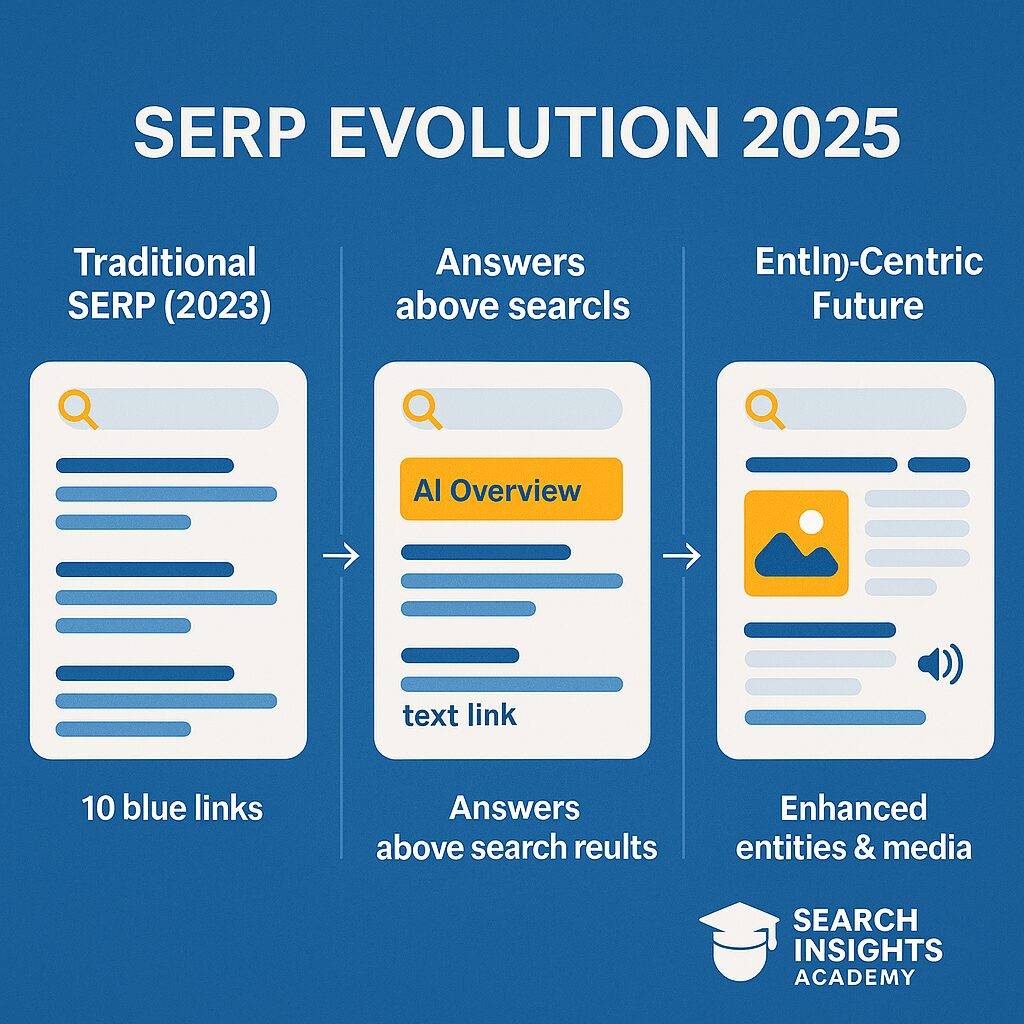
Beyond text, Google is investing more in audio-visual search. But here’s the catch: they don’t measure the same thing. And if you’re blindly relying on one without understanding the difference, you might be missing out on smarter SEO decisions.
Creating entity-centric video content or even short podcasts can expand your brand’s coverage. The same logic applies: thorough, engaging coverage triggers better visibility—and that’s the future of search optimization.
Search Engine Land’s BrightEdge data shows 7-10 percentage-point CTR loss for the #1 organic result when an Overview fires.
Page Speed & Technical Performance Impact
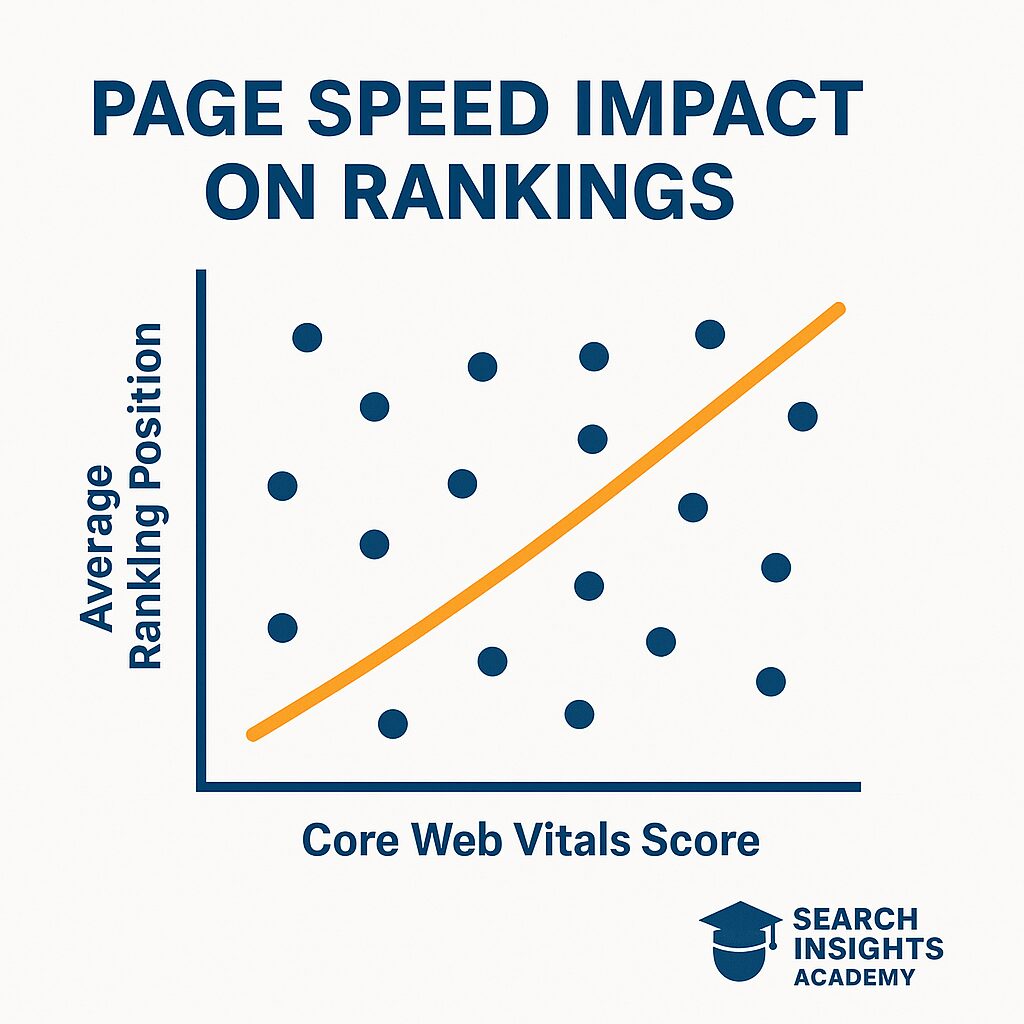
Hypothesis & Method for Improving Load Times
Website performance has become a critical factor in both user experience and SEO rankings. Page speed is an important Google ranking factor — but it’s also one of the most poorly understood by digital marketers. Page speed is the amount of time between when a browser sends a request to access a page and when the page renders the content.
Our hypothesis is that improving site speed not only enhances user experience but also strengthens topical authority signals by enabling deeper crawling and better engagement metrics.
To test this, we implemented a multi-phase approach:
- Baseline measurement of current performance metrics
- Systematic optimization of core web vitals
- Measurement of impact on crawl rates and user behavior signals
- Correlation analysis against ranking improvements
Tools: PageSpeed Insights & Lighthouse
Two essential tools for measuring page performance are PageSpeed Insights (PSI) which reports on the user experience of a page on both mobile and desktop devices, and provides suggestions on how that page may be improved. PSI provides both lab and field data about a page. Lab data is useful for debugging issues, as it is collected in a controlled environment. However, it may not capture real-world bottlenecks.
Using these tools in tandem provides a comprehensive view of your site’s performance from both lab testing and real-world user perspectives.
Key Findings & Recommended Steps
Our analysis revealed several critical factors affecting authority hub performance. These metrics are crucial in assessing user experience and optimizing website performance. A core web vitals assessment can help you understand how your website’s loading times, represented by First Contentful Paint (FCP) and First Input Delay (FID), compared to other sites.
Based on our research, we recommend the following steps to optimize your topical authority hub:
- Image Optimization: Implement next-gen formats (WebP, AVIF) and responsive image loading
- JavaScript Optimization: Defer non-critical JS and eliminate render-blocking resources
- Content Delivery Network: Implement a CDN to reduce server response times and improve TTFB
- Core Web Vitals Focus: Prioritize LCP, CLS, and INP optimization over less important metrics
- Server Performance: Upgrade hosting or implement server-side caching to improve response times
Conclusion: The Long-Game of Topical Authority
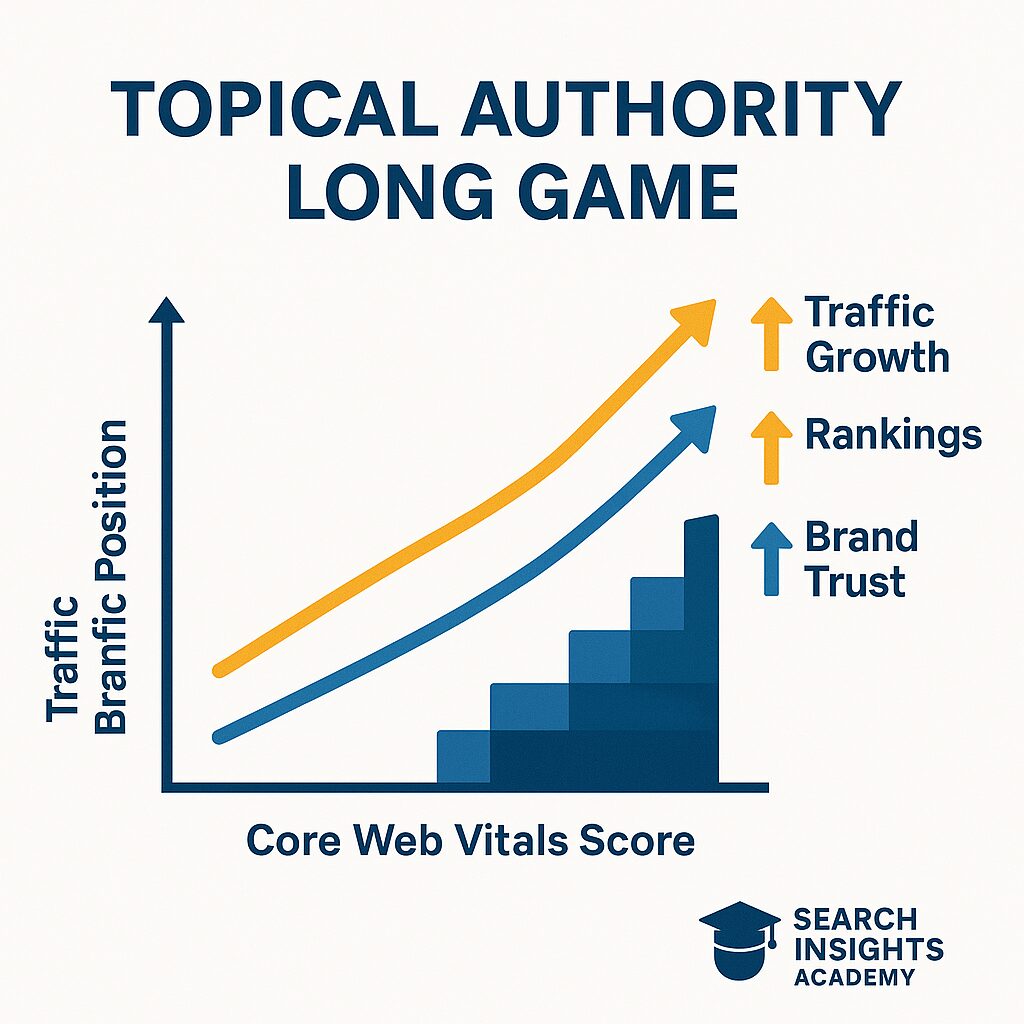
If you’ve made it this far, you probably see why topical authority has replaced simple keyword tricks. Delivering thorough, reliable content around a single subject ensures Google knows—beyond doubt—that you’re a leader in your field.
Page-level topical authority is now the strongest on-page ranking factor, beating domain‐wide traffic by 3× in predictive power, according to SurferSEO’s analysis of 253,800 SERPs.
Summing up, consider how your content architecture, on-page signals, and off-page reinforcement come together to strengthen your brand’s authority. From the creation of a pillar page to building support posts, ensuring structured data, and measuring your success, every step feeds into a cohesive strategy.
Ultimately, the long-term playbook for SEO success hinges on understanding Google’s entity-driven mindset. The more your content ecosystem reflects genuine expertise, the more it attracts organic traffic and brand trust. By consistently publishing well-structured, updated posts—and validating them through credible links and user engagement—you set your site up for unstoppable growth both now and in the future.

